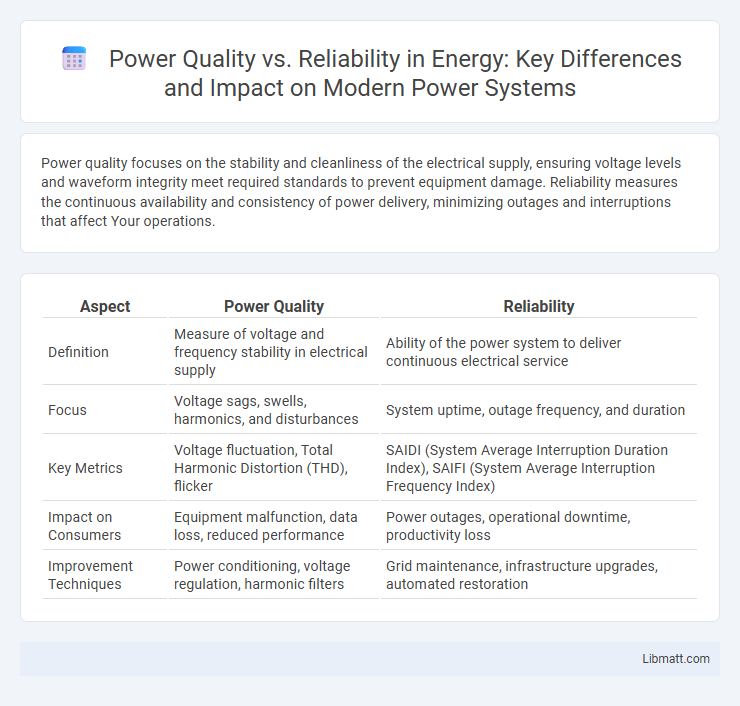Power quality focuses on the stability and cleanliness of the electrical supply, ensuring voltage levels and waveform integrity meet required standards to prevent equipment damage. Reliability measures the continuous availability and consistency of power delivery, minimizing outages and interruptions that affect Your operations.
Table of Comparison
| Aspect | Power Quality | Reliability |
|---|---|---|
| Definition | Measure of voltage and frequency stability in electrical supply | Ability of the power system to deliver continuous electrical service |
| Focus | Voltage sags, swells, harmonics, and disturbances | System uptime, outage frequency, and duration |
| Key Metrics | Voltage fluctuation, Total Harmonic Distortion (THD), flicker | SAIDI (System Average Interruption Duration Index), SAIFI (System Average Interruption Frequency Index) |
| Impact on Consumers | Equipment malfunction, data loss, reduced performance | Power outages, operational downtime, productivity loss |
| Improvement Techniques | Power conditioning, voltage regulation, harmonic filters | Grid maintenance, infrastructure upgrades, automated restoration |
Introduction to Power Quality and Reliability
Power quality refers to the stability and purity of electrical power, ensuring voltage, frequency, and waveform consistency for optimal performance of electrical devices. Reliability measures the continuous availability and consistent delivery of electrical power without interruptions or failures. Understanding both concepts is essential for maintaining efficient energy systems, as your equipment depends on high power quality and reliability to avoid downtime and damage.
Defining Power Quality: Key Parameters
Power quality refers to the characteristics of the electrical power supplied to consumers that affect the performance and operation of electrical devices. Key parameters defining power quality include voltage magnitude, frequency stability, harmonic distortion, and transient events such as voltage sags, swells, and interruptions. These parameters ensure the electrical supply meets proper standards, minimizing equipment malfunctions, data loss, and operational disruptions.
Understanding Reliability in Electrical Systems
Reliability in electrical systems refers to the consistent and uninterrupted delivery of power over time, minimizing outages and equipment failures. It involves factors such as system design, maintenance practices, and real-time monitoring to ensure stable operation under varying load conditions and external disturbances. Power quality impacts reliability by influencing voltage stability, harmonic distortion, and transient disturbances that can lead to equipment malfunctions or downtime.
Major Differences: Power Quality vs. Reliability
Power quality refers to the characteristics of electrical power that affect the performance and lifespan of equipment, including voltage stability, frequency consistency, and waveform purity. Reliability focuses on the continuous availability of power supply without interruptions or outages, ensuring consistent energy delivery to consumers. The major difference lies in power quality addressing the nature of the delivered power, while reliability emphasizes the uninterrupted access to that power.
Causes of Poor Power Quality
Poor power quality is primarily caused by voltage sags, swells, and harmonics, often resulting from faulty equipment, lightning strikes, and switching operations in the electrical grid. Frequent power outages and equipment failures can also stem from inadequate maintenance and outdated infrastructure, impacting the overall reliability of your electrical system. Addressing these issues is crucial to improving both power quality and system reliability for consistent performance.
Common Reliability Challenges in Power Systems
Power quality issues such as voltage sags, swells, and harmonic distortions frequently contribute to reliability challenges in power systems by causing equipment malfunctions and outages. Common reliability challenges include transient faults, aging infrastructure, and fluctuating load demands, which disrupt consistent power delivery and degrade system performance. Effective monitoring and maintenance strategies are critical for mitigating these challenges and ensuring stable, high-quality electrical supply.
Impacts of Power Quality Issues on Reliability
Power quality issues such as voltage sags, harmonics, and transients directly impact system reliability by causing equipment malfunctions, increased maintenance costs, and unexpected downtime. Distorted power signals reduce the lifespan of sensitive devices, leading to frequent failures and compromised operational continuity. Your business operations depend on maintaining stable power quality to ensure high reliability and prevent costly disruptions.
Monitoring and Measuring Power Quality and Reliability
Monitoring power quality involves tracking parameters such as voltage sags, swells, harmonics, and transients to detect anomalies that may affect equipment performance. Reliability measurement focuses on metrics like system uptime, failure rates, and mean time to repair (MTTR) to ensure continuous power delivery. You can enhance your electrical system by integrating advanced monitoring tools that provide real-time data for both power quality and reliability assessment.
Solutions for Enhancing Power Quality and System Reliability
Solutions for enhancing power quality and system reliability include installing power conditioners such as voltage regulators, surge protectors, and harmonic filters to mitigate disturbances like voltage sags, surges, and harmonics. Implementing uninterruptible power supplies (UPS) and advanced monitoring systems helps ensure continuous power and quick fault detection, thereby improving system uptime. You can also enhance reliability by integrating redundant power sources and performing regular maintenance to prevent equipment failures.
Future Trends in Power Quality and Reliability Management
Future trends in power quality and reliability management emphasize the integration of smart grid technologies, advanced monitoring systems, and predictive analytics to enhance system resilience and minimize outages. Increasing adoption of distributed energy resources and renewable energy sources requires adaptive strategies to manage voltage fluctuations and harmonics while ensuring consistent power delivery. Your ability to harness real-time data and artificial intelligence will be crucial for proactive maintenance and optimized grid performance in evolving energy landscapes.
Power quality vs Reliability Infographic

 libmatt.com
libmatt.com